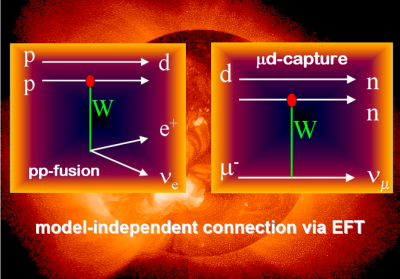A peek inside the earliest moments of the universe

The Big Bang. That spontaneous explosion some 14 billion years ago that created our universe and, in the process, all matter as we know it today.
In the first few minutes following "the bang," the universe quickly began expanding and cooling, allowing the formation of subatomic particles that joined forces to become protons and neutrons. These particles then began interacting with one another to create the first simple atoms. A little more time, a little more expansion, a lot more cooling—along with ever-present gravitational pull—and clouds of these elements began to morph into stars and galaxies.
For William Detmold, an assistant professor of physics at MIT who uses lattice quantum chromodynamics (LQCD) to study subatomic particles, one of the most interesting aspects of the formation of the early universe is what happened in those first few minutes—a period known as the "big bang nucleosynthesis."
"You start off with very high-energy particles that cool down as the universe expands, and eventually you are left with a soup of quarks and gluons, which are strongly interacting particles, and they form into protons and neutrons," he said. "Once you have protons and neutrons, the next stage is for those protons and neutrons to come together and start making more complicated things—primarily deuterons, which interact with other neutrons and protons and start forming heavier elements, such as Helium-4, the alpha particle."
One of the most critical aspects of big bang nucleosynthesis is the radiative capture process, in which a proton captures a neutron and fuses to produce a deuteron and a photon. In a paper published in Physical Review Letters, Detmold and his co-authors—all members of the NPLQCD Collaboration, which studies the properties, structures and interactions of fundamental particles—describe how they used LQCD calculations to better understand this process and precisely measure the nuclear reaction rate that occurs when a neutron and proton form a deuteron. While physicists have been able to experimentally measure these phenomena in the laboratory, they haven't been able to do the same, with certainty, using calculations alone—until now.
"One of the things that is very interesting about the strong interaction that takes place in the radiative capture process is that you get very complicated structures forming, not just protons and neutrons," Detmold said. "The strong interaction has this ability to have these very different structures coming out of it, and if these primordial reactions didn't happen the way they happened, we wouldn't have formed enough deuterium to form enough helium that then goes ahead and forms carbon. And if we don't have carbon, we don't have life."
Calculations Mirror Experiments
For the Physical Review Letters paper, the team used the Chroma LQCD code developed at Jefferson Lab to run a series of calculations with quark masses that were 10-20 times the physical value of those masses. Using heavier values rather than the actual physical values reduced the cost of the calculations tremendously, Detmold noted. They then used their understanding of how the calculations should depend on mass to get to the physical value of the quark mass.
"When we do an LQCD calculation, we have to tell the computer what the masses of the quarks we want to work with are, and if we use the values that the quark masses have in nature it is very computationally expensive," he explained. "For simple things like calculating the mass of the proton, we just put in the physical values of the quark masses and go from there. But this reaction is much more complicated, so we can't currently do the entire thing using the actual physical values of the quark masses.
While this is the first LQCD calculation of an inelastic nuclear reaction, Detmold is particularly excited by the fact that being able to reproduce this process through calculations means researchers can now calculate other things that are similar but that haven't been measured as precisely experimentally—such as the proton-proton fusion process that powers the sun—or measured at all.
"The rate of the radiative capture reaction, which is really what we are calculating here, is very, very close to the experimentally measured one, which shows that we actually understand pretty well how to do this calculation, and we've now done it, and it is consistent with what is experimentally known," Detmold said. "This opens up a whole range of possibilities for other nuclear interactions that we can try and calculate where we don't know what the answer is because we haven't, or can't, measure them experimentally. Until this calculation, I think it is fair to say that most people were wary of thinking you could go from quark and gluon degrees of freedom to doing nuclear reactions. This research demonstrates that yes, we can."
More information: Silas R. Beane et al. Calculation of theRadiative Capture Process, Physical Review Letters (2015). DOI: 10.1103/PhysRevLett.115.132001
Journal information: Physical Review Letters
Provided by Lawrence Berkeley National Laboratory




















